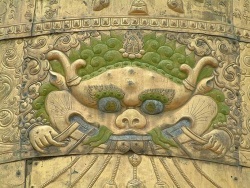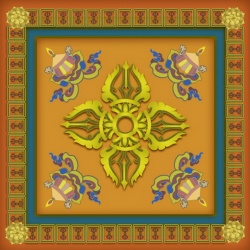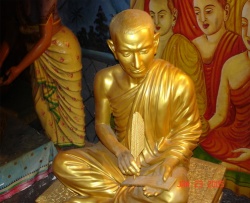Difference between revisions of "Metaphysical vision of ancient Japanese esoteric Buddhism"
(Created page with " <poem> Although already a significant presence in the Nara period, only in the {{Wiki|Heian period}} (794–1185) did Buddhism undergo a profound process of philos...") |
|||
| (One intermediate revision by the same user not shown) | |||
| Line 1: | Line 1: | ||
| − | + | {{DisplayImages|1874|823|722|1277}} | |
<poem> | <poem> | ||
Although already a significant presence in the [[Nara period]], only in the {{Wiki|Heian period}} (794–1185) did [[Buddhism]] undergo a profound process of [[philosophical]] development and Japanization. Two [[Buddhist]] thinkers were particularly influential: [[Kūkai]] (774–835; posthumous title, [[Kōbō Daishi]]) and [[Saichō]] (767–822; posthumous title, Dengyō [[Daishi]]). Of the two, Kūkai’s [[philosophical]] contribution was the more comprehensive. He went to [[China]] in 804 to study [[esoteric Buddhism]] and, upon his return two years later, founded [[Japanese]] [[Shingon Buddhism]]. The analytic and systematic [[character]] of Kūkai’s writings may well qualify him as the first true [[philosopher]] in [[Japanese]] history. | Although already a significant presence in the [[Nara period]], only in the {{Wiki|Heian period}} (794–1185) did [[Buddhism]] undergo a profound process of [[philosophical]] development and Japanization. Two [[Buddhist]] thinkers were particularly influential: [[Kūkai]] (774–835; posthumous title, [[Kōbō Daishi]]) and [[Saichō]] (767–822; posthumous title, Dengyō [[Daishi]]). Of the two, Kūkai’s [[philosophical]] contribution was the more comprehensive. He went to [[China]] in 804 to study [[esoteric Buddhism]] and, upon his return two years later, founded [[Japanese]] [[Shingon Buddhism]]. The analytic and systematic [[character]] of Kūkai’s writings may well qualify him as the first true [[philosopher]] in [[Japanese]] history. | ||
| Line 9: | Line 9: | ||
Another [[philosophical]] issue of [[interest]] to [[Kūkai]] was the [[nature]] of expression. Because the [[cosmos]] is a [[person]], [[reality]] is the expressive style of that [[person]]. Every [[entity]] is, therefore, a [[symbol]] or imprint of [[Dainichi’s]] [[mental]], somatic and [[verbal]] [[activity]]. Yet, because we contain the [[element]] of [[volitional]] [[consciousness]], we [[humans]] can also ignore the true source of all [[activity]], construing ourselves as independent entities. We can interpret things through the superimposition of our own imprints, covering over their (and our) more fundamental [[nature]]. This [[delusion]] is the source of [[human]] anguish and [[ignorance]]. The escape from [[delusion]] lies in [[recognizing]] and participating in the self-expressive [[nature]] of [[reality]]. | Another [[philosophical]] issue of [[interest]] to [[Kūkai]] was the [[nature]] of expression. Because the [[cosmos]] is a [[person]], [[reality]] is the expressive style of that [[person]]. Every [[entity]] is, therefore, a [[symbol]] or imprint of [[Dainichi’s]] [[mental]], somatic and [[verbal]] [[activity]]. Yet, because we contain the [[element]] of [[volitional]] [[consciousness]], we [[humans]] can also ignore the true source of all [[activity]], construing ourselves as independent entities. We can interpret things through the superimposition of our own imprints, covering over their (and our) more fundamental [[nature]]. This [[delusion]] is the source of [[human]] anguish and [[ignorance]]. The escape from [[delusion]] lies in [[recognizing]] and participating in the self-expressive [[nature]] of [[reality]]. | ||
| − | Kūkai’s contemporary and major competitor, [[Saichō]], founded [[Japanese]] [[Tendai]] [[Buddhism]]. Although Saichō’s primary goal in visiting [[China]] was to bring back to [[Japan]] the [[teaching]] of the [[Tiantai]] [[Buddhist tradition]] (see [[Buddhist philosophy]], {{Wiki|Chinese}} §7), he also had a chance encounter with a [[teacher]] of [[esotericism]]. When he returned to [[Japan]], therefore, his [[Tendai school]] incorporated [[esoteric]] [[Buddhist]] [[elements]] as well as [[exoteric]] [[Tiantai]] teachings. Through the exchange of [[Shingon]] and [[Tendai]] [[disciples]] in [[Japan]], some of Kūkai’s [[esoteric teachings]] also found their way into [[Tendai]]. The result was that by the end of the ninth century, the two dominant [[forms]] of [[Japanese Buddhism]] were both at least partially [[esoteric]] in [[nature]]. | + | Kūkai’s contemporary and major competitor, [[Saichō]], founded [[Japanese]] [[Tendai]] [[Buddhism]]. Although [[Saichō’s]] primary goal in visiting [[China]] was to bring back to [[Japan]] the [[teaching]] of the [[Tiantai]] [[Buddhist tradition]] (see [[Buddhist philosophy]], {{Wiki|Chinese}} §7), he also had a chance encounter with a [[teacher]] of [[esotericism]]. When he returned to [[Japan]], therefore, his [[Tendai school]] incorporated [[esoteric]] [[Buddhist]] [[elements]] as well as [[exoteric]] [[Tiantai]] teachings. Through the exchange of [[Shingon]] and [[Tendai]] [[disciples]] in [[Japan]], some of [[Kūkai’s]] [[esoteric teachings]] also found their way into [[Tendai]]. The result was that by the end of the ninth century, the two dominant [[forms]] of [[Japanese Buddhism]] were both at least partially [[esoteric]] in [[nature]]. |
We can explain the influence of the [[esoteric]] [[Buddhist]] {{Wiki|theory}} of [[reality]] from both the standpoint of {{Wiki|cultural}} history and the history of [[philosophy]]. Culturally, it is important that [[esoteric Buddhism]] did not either doctrinally or {{Wiki|politically}} oppose the presence of the indigenous [[religion]], [[Shintō]]. [[Esoteric Buddhism]] reinforced rather than challenged many aspects of the indigenous [[religious]] worldview: the {{Wiki|ubiquity}} of the [[sacred]], the expressiveness of [[nature]] and the [[nonduality]] of matter and [[spirit]], for example. Furthermore, both [[Kūkai]] and [[Saichō]] correlated the various [[buddhas]] of [[esotericism]] with the various [[kami]] of the [[traditional]] [[Japanese]] [[religion]]. By this process, [[Japanese]] {{Wiki|archaism}} was, in effect, defended by a {{Wiki|philosophically}} sophisticated system of [[Buddhist]] [[thought]] imported from the mainland and adapted to the [[Japanese]] context. [[Buddhism]] and [[Shintō]] could therefore be practised alongside each other without contradiction. | We can explain the influence of the [[esoteric]] [[Buddhist]] {{Wiki|theory}} of [[reality]] from both the standpoint of {{Wiki|cultural}} history and the history of [[philosophy]]. Culturally, it is important that [[esoteric Buddhism]] did not either doctrinally or {{Wiki|politically}} oppose the presence of the indigenous [[religion]], [[Shintō]]. [[Esoteric Buddhism]] reinforced rather than challenged many aspects of the indigenous [[religious]] worldview: the {{Wiki|ubiquity}} of the [[sacred]], the expressiveness of [[nature]] and the [[nonduality]] of matter and [[spirit]], for example. Furthermore, both [[Kūkai]] and [[Saichō]] correlated the various [[buddhas]] of [[esotericism]] with the various [[kami]] of the [[traditional]] [[Japanese]] [[religion]]. By this process, [[Japanese]] {{Wiki|archaism}} was, in effect, defended by a {{Wiki|philosophically}} sophisticated system of [[Buddhist]] [[thought]] imported from the mainland and adapted to the [[Japanese]] context. [[Buddhism]] and [[Shintō]] could therefore be practised alongside each other without contradiction. | ||
| − | This development set the [[metaphysical]] backdrop against which later [[Japanese]] [[thought]] would develop. One might say that [[esoteric Buddhism]] did for [[Japanese]] [[philosophy]] what {{Wiki|Plato}} and {{Wiki|Aristotle}} did for {{Wiki|Western philosophy}}. It laid out a set of assumptions and a | + | This development set the [[metaphysical]] backdrop against which later [[Japanese]] [[thought]] would develop. One might say that [[esoteric Buddhism]] did for [[Japanese]] [[philosophy]] what {{Wiki|Plato}} and {{Wiki|Aristotle}} did for {{Wiki|Western philosophy}}. It laid out a set of assumptions and a Problematic that had a profound influence on the [[thought]] to follow. Two assumptions were particularly influential. |
First, [[esotericism]] has a {{Wiki|distinctive}} [[view]] of the [[relation]] between part and whole. The whole is recursively [[manifest]] or reflected in the part. It is not that the parts constitute the whole nor that the whole is more than the sum of its parts; rather, since the part is what it is by [[virtue]] of the whole, if we truly understand the part, we find the whole imprinted in it. In Shingon’s case, for example, since any {{Wiki|individual}} thing is an expression of the [[cosmos]] as [[Dainichi]], when we truly understand the part (the {{Wiki|individual}} thing), we encounter the whole ([[Dainichi]]) as well. | First, [[esotericism]] has a {{Wiki|distinctive}} [[view]] of the [[relation]] between part and whole. The whole is recursively [[manifest]] or reflected in the part. It is not that the parts constitute the whole nor that the whole is more than the sum of its parts; rather, since the part is what it is by [[virtue]] of the whole, if we truly understand the part, we find the whole imprinted in it. In Shingon’s case, for example, since any {{Wiki|individual}} thing is an expression of the [[cosmos]] as [[Dainichi]], when we truly understand the part (the {{Wiki|individual}} thing), we encounter the whole ([[Dainichi]]) as well. | ||
| Line 19: | Line 19: | ||
With this orientation as a {{Wiki|cultural}} presupposition, later [[Japanese]] [[philosophers]] would seldom endorse either atomistic analysis or {{Wiki|individualism}} (see {{Wiki|Atomism}}, {{Wiki|ancient}}; Methodological {{Wiki|individualism}}). Atomistic analysis had been introduced into [[Japan]] via the Nara Schools of Jōjitsu and [[Kusha]]. [[Kūkai]] explicitly ranked them as [[philosophical]] ‘[[mindsets]]’ far below [[Kegon]] and [[Tendai]], in part because only the latter endorsed this {{Wiki|theory}} of whole-as-part. {{Wiki|Individualism}}, with attendant theories of {{Wiki|social}} contract, entered [[Japan]] via the [[West]] only in the late nineteenth century. Since it viewed the {{Wiki|social}} whole as constituted by the parts, it ran counter to this [[esoteric]] assumption. Not surprisingly, {{Wiki|individualism}} has never taken hold in [[Japan]] as a basis for {{Wiki|social}}, [[ethical]] or {{Wiki|political}} {{Wiki|theory}}. | With this orientation as a {{Wiki|cultural}} presupposition, later [[Japanese]] [[philosophers]] would seldom endorse either atomistic analysis or {{Wiki|individualism}} (see {{Wiki|Atomism}}, {{Wiki|ancient}}; Methodological {{Wiki|individualism}}). Atomistic analysis had been introduced into [[Japan]] via the Nara Schools of Jōjitsu and [[Kusha]]. [[Kūkai]] explicitly ranked them as [[philosophical]] ‘[[mindsets]]’ far below [[Kegon]] and [[Tendai]], in part because only the latter endorsed this {{Wiki|theory}} of whole-as-part. {{Wiki|Individualism}}, with attendant theories of {{Wiki|social}} contract, entered [[Japan]] via the [[West]] only in the late nineteenth century. Since it viewed the {{Wiki|social}} whole as constituted by the parts, it ran counter to this [[esoteric]] assumption. Not surprisingly, {{Wiki|individualism}} has never taken hold in [[Japan]] as a basis for {{Wiki|social}}, [[ethical]] or {{Wiki|political}} {{Wiki|theory}}. | ||
| − | Second, esotericism’s [[metaphysics]] argued that [[reality]] is self-expressive. [[Human beings]] are, of course, part of [[reality]]. When [[humans]] speak authentically or truly, therefore, they do not refer to [[reality]], but rather are part of its self-expression. This position undermines any [[philosophical]] tendencies toward {{Wiki|idealism}} ([[reality]] as a production of [[mind]]), realism ([[reality]] as pre-existing our expressions and [[truth]] as matching our expressions with that [[reality]]) or radical {{Wiki|nominalism}} (expressions refer primarily to other expressions without necessary connection to non-linguistic [[reality]]) (see {{Wiki|Idealism}}; Realism and antirealism; {{Wiki|Nominalism}}). In the Nara Schools there were variants of {{Wiki|idealism}} ([[Hossō]]), realism ([[Kusha]] and Jōjitsu) and {{Wiki|nominalism}} ([[Sanron]]). Again [[Kūkai]] ranked them all below [[Kegon]] and [[Tendai]], and certainly below what he believed to be the only comprehensive mind-set, [[esotericism]]. | + | Second, [[esotericism’s]] [[metaphysics]] argued that [[reality]] is self-expressive. [[Human beings]] are, of course, part of [[reality]]. When [[humans]] speak authentically or truly, therefore, they do not refer to [[reality]], but rather are part of its self-expression. This position undermines any [[philosophical]] tendencies toward {{Wiki|idealism}} ([[reality]] as a production of [[mind]]), realism ([[reality]] as pre-existing our expressions and [[truth]] as matching our expressions with that [[reality]]) or radical {{Wiki|nominalism}} (expressions refer primarily to other expressions without necessary connection to non-linguistic [[reality]]) (see {{Wiki|Idealism}}; Realism and antirealism; {{Wiki|Nominalism}}). In the [[Nara Schools]] there were variants of {{Wiki|idealism}} ([[Hossō]]), realism ([[Kusha]] and [[Jōjitsu]]) and {{Wiki|nominalism}} ([[Sanron]]). Again [[Kūkai]] ranked them all below [[Kegon]] and [[Tendai]], and certainly below what he believed to be the only comprehensive mind-set, [[esotericism]]. |
| − | This presupposition about the self-expressive [[nature]] of [[reality]] underlies most [[Japanese]] {{Wiki|aesthetic}} theories as well. The {{Wiki|Heian period}} was the first to develop a detailed set of {{Wiki|aesthetic}} terms, for example, miyabi (cultured, refined elegance) and mono no aware (the ‘ah-ness of things’ or the {{Wiki|aesthetic}} tinge of [[sadness]] [[arising]] from an [[appreciation]] of the evanescent). In later periods, other {{Wiki|aesthetic}} terms such as yūgen (hidden sublimity or depth), sabi (the ‘loneliness’ of an elegance allowed to age) and wabi (rusticity) came to the fore. These terms have rich connotations not readily translated into English. In general, though, they signify equally a quality of the [[object]] and the response of the aesthete or artist. The {{Wiki|aesthetic}} is understood to be a self-expressive resonance between the [[object]] and artist. The [[world]] expresses itself through the artist as the work of [[art]] (see Aesthetics, [[Japanese]]). | + | This presupposition about the self-expressive [[nature]] of [[reality]] underlies most [[Japanese]] {{Wiki|aesthetic}} theories as well. The {{Wiki|Heian period}} was the first to develop a detailed set of {{Wiki|aesthetic}} terms, for example, miyabi (cultured, refined elegance) and mono no aware (the ‘ah-ness of things’ or the {{Wiki|aesthetic}} tinge of [[sadness]] [[arising]] from an [[appreciation]] of the evanescent). In later periods, other {{Wiki|aesthetic}} terms such as yūgen (hidden sublimity or depth), [[sabi]] (the ‘loneliness’ of an elegance allowed to age) and wabi (rusticity) came to the fore. These terms have rich connotations not readily translated into English. In general, though, they signify equally a quality of the [[object]] and the response of the aesthete or artist. The {{Wiki|aesthetic}} is understood to be a self-expressive resonance between the [[object]] and artist. The [[world]] expresses itself through the artist as the work of [[art]] (see Aesthetics, [[Japanese]]). |
</poem> | </poem> | ||
{{R}} | {{R}} | ||
[http://www.rep.routledge.com/article/G100SECT3 www.rep.routledge.com] | [http://www.rep.routledge.com/article/G100SECT3 www.rep.routledge.com] | ||
[[Category:Esoteric Buddhism]] | [[Category:Esoteric Buddhism]] | ||
| + | [[Category:Japanese Buddhism]] | ||
Latest revision as of 22:24, 14 December 2013
Although already a significant presence in the Nara period, only in the Heian period (794–1185) did Buddhism undergo a profound process of philosophical development and Japanization. Two Buddhist thinkers were particularly influential: Kūkai (774–835; posthumous title, Kōbō Daishi) and Saichō (767–822; posthumous title, Dengyō Daishi). Of the two, Kūkai’s philosophical contribution was the more comprehensive. He went to China in 804 to study esoteric Buddhism and, upon his return two years later, founded Japanese Shingon Buddhism. The analytic and systematic character of Kūkai’s writings may well qualify him as the first true philosopher in Japanese history.
For Kūkai, reality is fundamentally a person. The entire cosmos is no more than the thoughts, words and deeds of the Buddha called Dainichi (literally the ‘Great Sun’). Dainichi is not the creator of the universe; Dainichi is the universe. In a perpetual state of enlightened meditation, Dainichi performs the three great practices of esoteric Buddhism: the chanting of sacred syllables (mantras), the visualization of geometrical arrays of symbols (mandalas) and the performance of sacred postures or hand gestures (mudras). These three activities define the nature of the universe. The mantras are microcosmic resonances or vibrating states of matter–energy that constitute the basic elements. The mandalas define the essential structure, and the mudras constitute the patterns of change. By performing the rituals of mantra, mandala and mudra, a person achieves immediate insight into the nature of the cosmos. By introspection on the nature of their own thoughts, words and deeds, the Shingon Buddhist is said to achieve insight into the thoughts, words and deeds of the Buddha, Dainichi. By understanding one’s own person, one understands the person that is all of reality.
Within the framework of this metaphysical system, Kūkai developed a comprehensive philosophy addressing several major philosophical issues. For example, he criticized the idea that insight or enlightenment could be purely mental or intellectual. Because the universe itself consists of thought, word and deed (or structure, resonance and patterned change), it can only be grasped by unified praxis of the whole person: mind, speech and body. To know reality is to participate in it fully, in all three of its dimensions.
Another philosophical issue of interest to Kūkai was the nature of expression. Because the cosmos is a person, reality is the expressive style of that person. Every entity is, therefore, a symbol or imprint of Dainichi’s mental, somatic and verbal activity. Yet, because we contain the element of volitional consciousness, we humans can also ignore the true source of all activity, construing ourselves as independent entities. We can interpret things through the superimposition of our own imprints, covering over their (and our) more fundamental nature. This delusion is the source of human anguish and ignorance. The escape from delusion lies in recognizing and participating in the self-expressive nature of reality.
Kūkai’s contemporary and major competitor, Saichō, founded Japanese Tendai Buddhism. Although Saichō’s primary goal in visiting China was to bring back to Japan the teaching of the Tiantai Buddhist tradition (see Buddhist philosophy, Chinese §7), he also had a chance encounter with a teacher of esotericism. When he returned to Japan, therefore, his Tendai school incorporated esoteric Buddhist elements as well as exoteric Tiantai teachings. Through the exchange of Shingon and Tendai disciples in Japan, some of Kūkai’s esoteric teachings also found their way into Tendai. The result was that by the end of the ninth century, the two dominant forms of Japanese Buddhism were both at least partially esoteric in nature.
We can explain the influence of the esoteric Buddhist theory of reality from both the standpoint of cultural history and the history of philosophy. Culturally, it is important that esoteric Buddhism did not either doctrinally or politically oppose the presence of the indigenous religion, Shintō. Esoteric Buddhism reinforced rather than challenged many aspects of the indigenous religious worldview: the ubiquity of the sacred, the expressiveness of nature and the nonduality of matter and spirit, for example. Furthermore, both Kūkai and Saichō correlated the various buddhas of esotericism with the various kami of the traditional Japanese religion. By this process, Japanese archaism was, in effect, defended by a philosophically sophisticated system of Buddhist thought imported from the mainland and adapted to the Japanese context. Buddhism and Shintō could therefore be practised alongside each other without contradiction.
This development set the metaphysical backdrop against which later Japanese thought would develop. One might say that esoteric Buddhism did for Japanese philosophy what Plato and Aristotle did for Western philosophy. It laid out a set of assumptions and a Problematic that had a profound influence on the thought to follow. Two assumptions were particularly influential.
First, esotericism has a distinctive view of the relation between part and whole. The whole is recursively manifest or reflected in the part. It is not that the parts constitute the whole nor that the whole is more than the sum of its parts; rather, since the part is what it is by virtue of the whole, if we truly understand the part, we find the whole imprinted in it. In Shingon’s case, for example, since any individual thing is an expression of the cosmos as Dainichi, when we truly understand the part (the individual thing), we encounter the whole (Dainichi) as well.
With this orientation as a cultural presupposition, later Japanese philosophers would seldom endorse either atomistic analysis or individualism (see Atomism, ancient; Methodological individualism). Atomistic analysis had been introduced into Japan via the Nara Schools of Jōjitsu and Kusha. Kūkai explicitly ranked them as philosophical ‘mindsets’ far below Kegon and Tendai, in part because only the latter endorsed this theory of whole-as-part. Individualism, with attendant theories of social contract, entered Japan via the West only in the late nineteenth century. Since it viewed the social whole as constituted by the parts, it ran counter to this esoteric assumption. Not surprisingly, individualism has never taken hold in Japan as a basis for social, ethical or political theory.
Second, esotericism’s metaphysics argued that reality is self-expressive. Human beings are, of course, part of reality. When humans speak authentically or truly, therefore, they do not refer to reality, but rather are part of its self-expression. This position undermines any philosophical tendencies toward idealism (reality as a production of mind), realism (reality as pre-existing our expressions and truth as matching our expressions with that reality) or radical nominalism (expressions refer primarily to other expressions without necessary connection to non-linguistic reality) (see Idealism; Realism and antirealism; Nominalism). In the Nara Schools there were variants of idealism (Hossō), realism (Kusha and Jōjitsu) and nominalism (Sanron). Again Kūkai ranked them all below Kegon and Tendai, and certainly below what he believed to be the only comprehensive mind-set, esotericism.
This presupposition about the self-expressive nature of reality underlies most Japanese aesthetic theories as well. The Heian period was the first to develop a detailed set of aesthetic terms, for example, miyabi (cultured, refined elegance) and mono no aware (the ‘ah-ness of things’ or the aesthetic tinge of sadness arising from an appreciation of the evanescent). In later periods, other aesthetic terms such as yūgen (hidden sublimity or depth), sabi (the ‘loneliness’ of an elegance allowed to age) and wabi (rusticity) came to the fore. These terms have rich connotations not readily translated into English. In general, though, they signify equally a quality of the object and the response of the aesthete or artist. The aesthetic is understood to be a self-expressive resonance between the object and artist. The world expresses itself through the artist as the work of art (see Aesthetics, Japanese).



